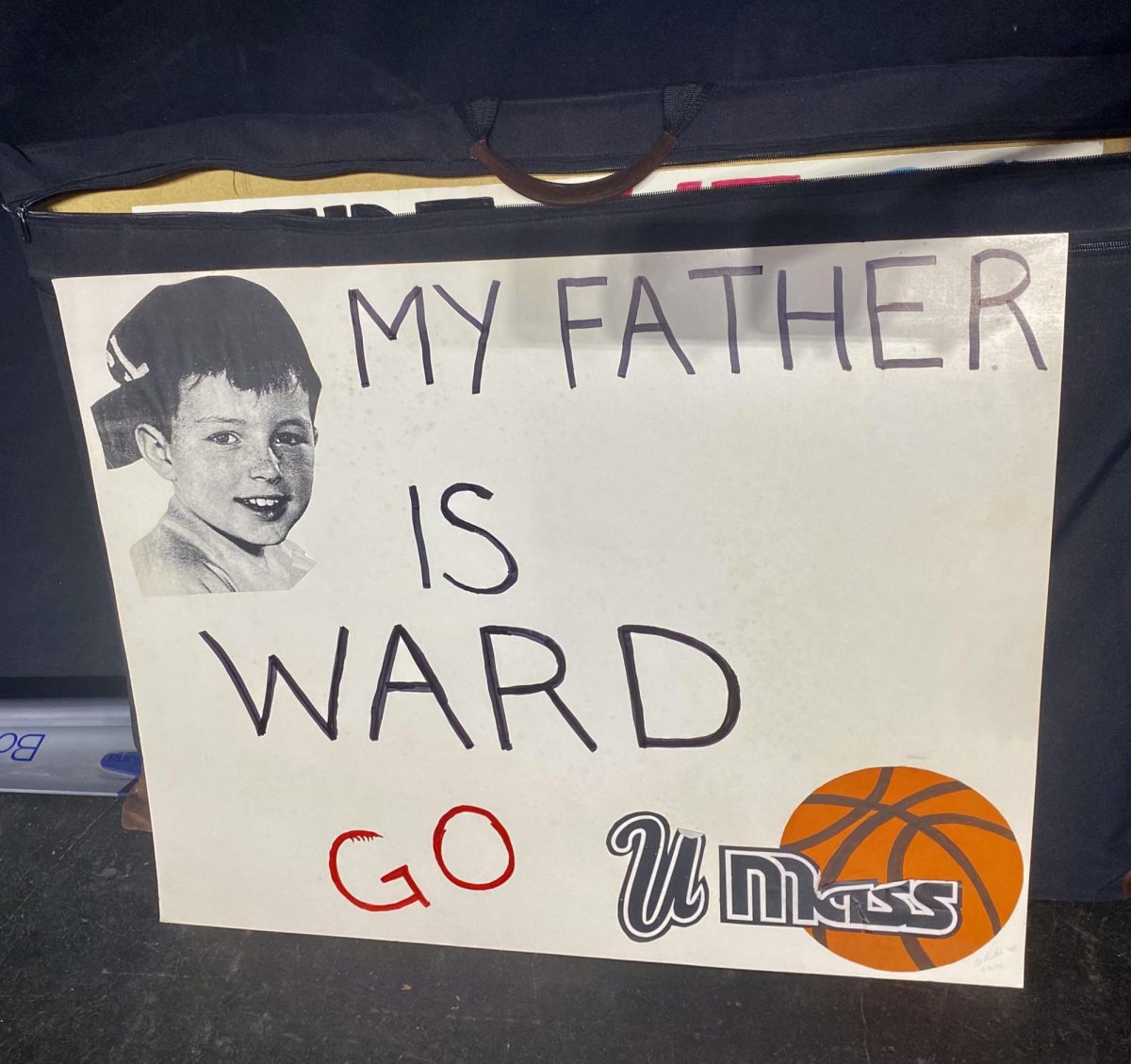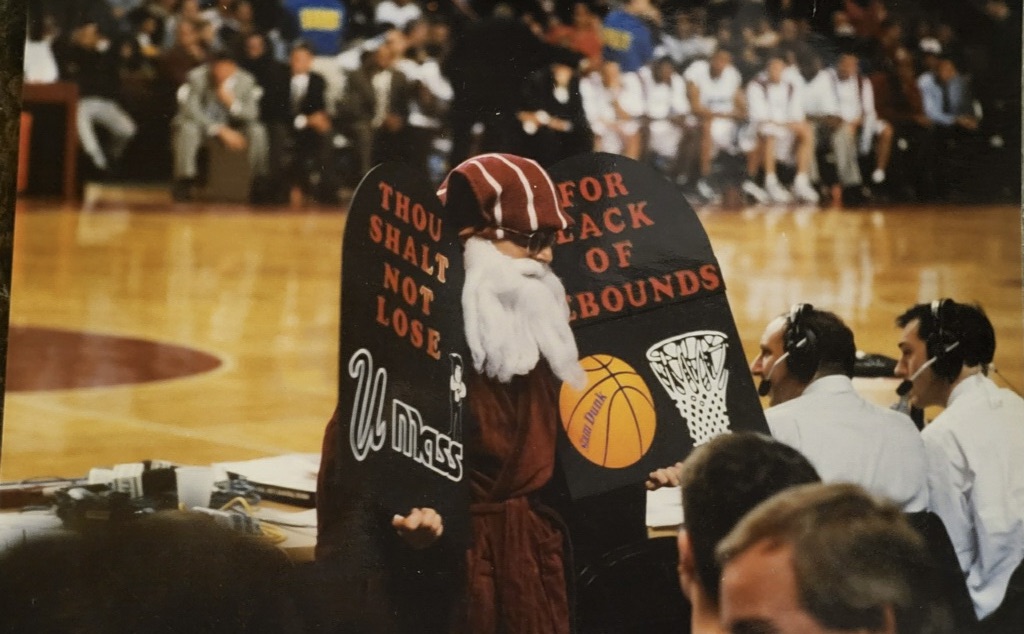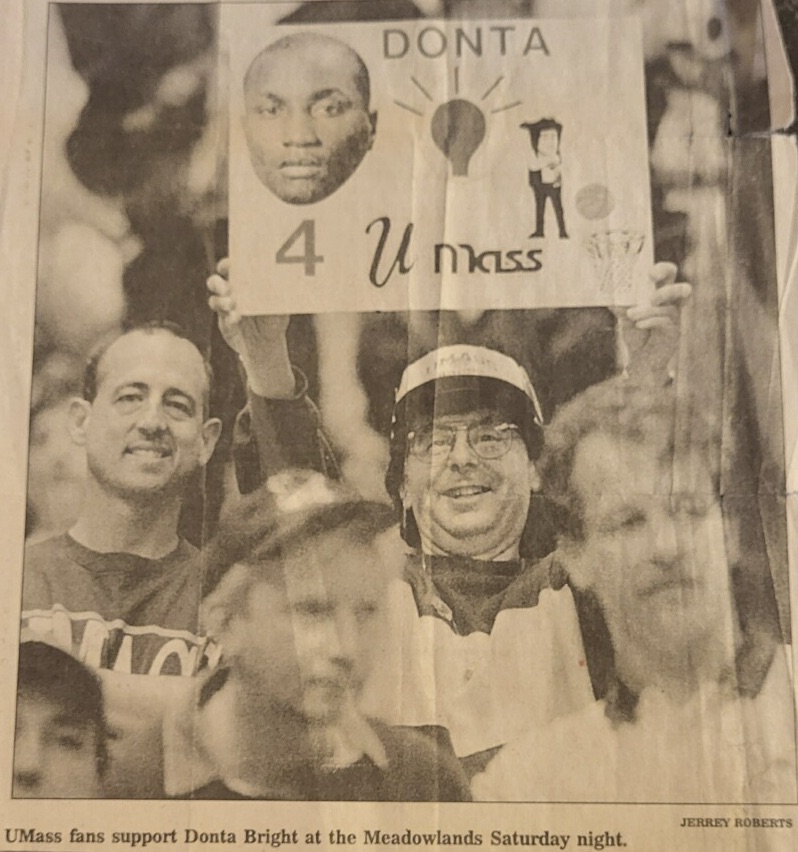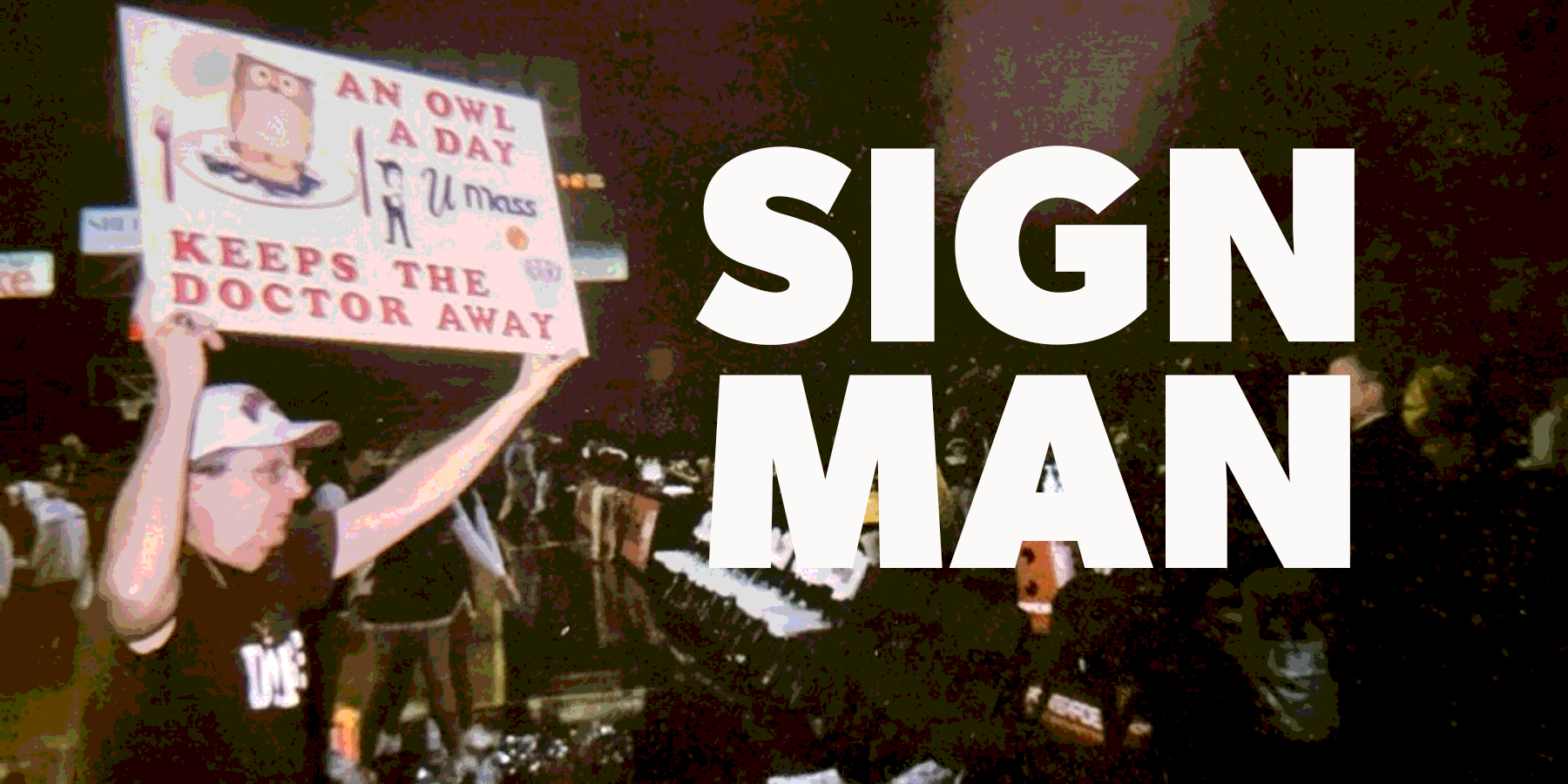Sign Man: A Fan’s Unmatched Legacy
The heritage of the fan who captivated a fanbase and witnessed every step of Massachusetts athletics history
April 25, 2024
A chapter of UMass history ended this spring.
As I sat courtside at the Mullins Center’s assigned media table during a Massachusetts men’s basketball game in November, an usher approached me and asked if I wrote for the Daily Collegian. He happened to be a Collegian alum, and he had a story for me; “Do you know the Sign Man?” he asked. “Did you know he’s retiring?”
During halftime of UMass’ December 9 game against UMass Lowell, I located 76-year-old Ed Rubin among the 3,028 fans at Mullins. Attendance lacked in comparison to the sold-out crowds Rubin entertained at the start of his career. The PA announcer and band trumpets and the song “Give Me Everything” by Pitbull smothered Rubin’s voice and thick Massachusetts accent.
We slowly walked down the stands and towards the barrier that sits in front of the bleachers. Rubin took off his long-distance glasses and left them on top of the barrier, against which his large black art portfolio bag leaned. He opened the bag and pulled out the first sign he ever made, the first of hundreds of pieces of UMass basketball history. He forgot his glasses when he went back to his seat.
Anyone who’s been to a men’s basketball game at UMass in the past 30 years has seen the Sign Man — a 5-foot-5-inch man who now has shoulder-length curly silver hair with bangs, and walks a lap around the court during media timeouts holding up enigmatic self-made signs with pictures, graphics and puns.
Rubin has done this for decades, and as such, has perfectly figured out the timing of a full lap around the parquet. The Mullins employee described him as the first true “meme” guy, before internet times.

Rubin has a special legacy in Amherst, Massachusetts. He’s not exactly a celebrity, but he’s likely the most famous UMass fan. He got his start in 1994, a year after the Mullins Center opened — but Rubin’s story at UMass goes even farther back. He’s not only a first-hand witness of almost every major step in the history of UMass men’s basketball, but he’s also part of that very history.
A native of Everett, Massachusetts who now lives in Harvard — no, Havahd — Rubin attended the University of Massachusetts from the fall of 1965 until he graduated in 1969 with a degree in finance. The following year he earned a master’s in finance from the University of Florida and built a successful career in finance working for himself.
Rubin had visions of being a great athlete when he arrived to campus, but he didn’t play sports in high school and weighed barely over 100 pounds. After his friends locked him in a room in Webster Hall to stop him from trying out for the football team, Rubin showed up to the soccer field instead, since he was told the freshman soccer team didn’t cut players. The freshman soccer coach at the time was future UMass Hall of Famer Jack Leaman.
They didn’t have a pair of cleats in Rubin’s size, so he wore a full size too big and kept tripping and falling flat on his face. Leaman treated Rubin like “a Greater Boston League All-Star,” when, in fact, he wasn’t.
When then-head basketball coach Johnny Orr left UMass for Michigan after 1966, Leaman took over head coaching duties — and Rubin became his basketball team manager. Throughout this time, they built a long-lasting relationship. Leaman often brought his young daughter to practices and Rubin kept an eye on her running up and down the bleachers in the Curry Hicks Cage.
Rubin was a fierce trash talker but first and foremost played to have fun. He always pushed for everybody to play. But his participation in sports got even more limited when he suffered a serious non-contact back injury and back spasms that gave him years of terrible pain. Rubin certainly never found an athletic career at UMass, but he met Leaman, one of the most influential people in his life, and he also met his wife.
As a senior, Rubin bumped shoulders with Ann Marie, a freshman. He started taking her to football games at McGuirk Alumni Stadium, which opened his freshman year. “I think I got a keeper here,” Rubin thought at the time. They’ve been married for 48 years and have two daughters.
The first time Rubin made a sign was in 1994. It was a play on words based on the formerly popular TV show “Leave it to Beaver,” conceived prior to No. 11 UMass men’s basketball’s sold-out home matchup against Florida State at the Mullins Center. Days before the game, Rubin sat in his off-white-colored home office. He opened his desk drawer and found a two-inch square picture of a young Jerry Mathers as Theodore “Beaver” Cleaver wearing a cap off to the side. Beaver Cleaver’s father in the show was Ward Cleaver. The Seminoles’ point guard at the time was Charlie Ward, the Heisman Trophy winner and quarterback of No. 1 Florida State. Rubin connected the dots.
He took the picture to Staples, made a large, lousy copy of it and used a glue stick to paste the photo on the top left corner of a big poster board. Then he got a marker.
“MY FATHER IS WARD”
At the game, Rubin took his sign and walked behind the Florida State bench. A 14 or 15-year-old child who Rubin thought was Charlie Ward’s relative came out of the third row in the stands and walked up to Rubin when he saw the sign. He started poking Rubin in the chest with his index finger, and then pointed at the sign.
“You wish it!” the kid said.
Naturally, he had no idea who Beaver Cleaver was, or his father. He thought that by “My father is Ward,” the mysterious man said that Charlie Ward was his father. Rubin laughed on the way back to his seat.
“I’m walking up the stairs and my friends say, ‘What’s so funny?’ I said, ‘At the break we’ll talk about it, but I think I might have something here,’” Rubin said, “which I never knew would last for 30 years.”

Many of his signs are contextless, sometimes undecipherable. It’s part of the reason the Sign Man became a sort of local celebrity.
When Rubin first started, a friend told him to call Mat Brown, a cartoon illustrator for Building #19. Brown said the best advice he can give is to make the signs “really eclectic and out there, that not too many people in the arena will understand,” and thus they’ll have to ask others for the meaning.
“And I’ve actually seen this happen,” Rubin said. “Somebody would look at me [holding a sign], shrug their shoulders, and I’d point to the person next to them. And then one by one down the row, 10 people, they would all shrug. And I’m like, ‘This is beautiful.’”
His wife, Ann Marie, supported his hobby completely. “It’s a real passion of his, he loves it and that’s a key part of who he is,” Ann Marie said. She added that his passion only grew over the years.
Rubin attributes his drive to keep going for years to those whom he made the signs for in the first place.
“Well, it was the fans! Just the people in Mullins,” Rubin said about his motivation. “Back when this started, we had sellouts of 9,400 people at all the games, and the fans took such a liking to this that they were expecting it.”
The Sign Man contributed to the UMass-Temple rivalry by using his signs to always make fun of the Owls. Some of his best work included a 10-foot pole with a plastic owl on the edge wearing a white and maroon UMass shirt, which he paired with a sign that said: “Dress for success.” Rubin walked up to the Temple team practicing before the game and held up the owl about 12 feet in the air. One of the players saw it and told everyone else to look at it; they stopped practice because they were laughing their heads off.

Rubin’s creative genius shows up unscheduled, he just has to be ready for it.
“I see things other people don’t see, I guess,” Rubin said, laughing. “I could wake up at three o’clock in the morning and bingo, there’s an idea. It’s just the way my brain functions.”
The clever signs, astounding dedication and a memorable look turned him into a Mullins Center staple. He gained notoriety and fans began to recognize him way beyond the Northeast. His signs often appeared on television broadcasts surrounded by UMass fans, and Rubin hopes it helped bring attention to the program. The joy expressed by fans fueled him for years.

In August of 1996, the year the Minutemen made the Final Four, Rubin called a marketing company to purchase basketballs of the exact same kind used in March Madness. He told the man on the phone that he was a UMass fan who made signs.
“Are you the one who made the Tyrone Weeks sign with the flashing red eyes that I saw last February on television on the national broadcast?” the man asked.
Rubin found purpose in a niche which he perfected. He started doing it at football games regularly in 1998.
On another instance, Rubin, Ann Marie and their younger daughter walked down the seashore of a nearly empty Cape Cod beach on a rainy day when a group of people about 50 feet from them screamed “Sign Man?!”
It was a regular occurrence. Fans in their late 20s often walk up to him at Mullins to say that they used to come to UMass games with their dad, asking if the man with the signs would be there, because they wanted to see him. A few times over the years, people have told him, “Do you mind if I ask you how much they pay you to do these signs?” Others have asked him what department he teaches in.
“Aren’t you a professor here?”
About 10 years ago, Rubin and Ann Marie were out for a cocktail party on a hot Monday night in the small tropical island Antigua & Barbuda, a place they’ve frequented during the wintertime for the last 20 years. Rubin made an announcement to the crowd that he had scheduled a cab for later in the evening to take him to a restaurant three miles down the road in case anyone wanted to go together.
Unexpectedly, when they got to the taxi four younger women had taken him up on the offer. The youngest was 27, the oldest was 42. Three of them said they were from the Northeast, but one was from California. Intrigued, Rubin asked her how she got there.
“Well, after UMass —” she began to say.
“Stop right there,” Rubin interrupted. “Did you ever go to ball games at the Mullins Center?”
“I worked there as an intern,” she said.
“You know me,” Rubin told her.
“You kind of look familiar. What’s your name?”
“If I told you my name, that would give you zero clue as to who I am.”
Rubin, Ann Marie and the four women ended up drinking wine and eating together on the second floor of OJ’s Beach Bar & Restaurant, a teal and white wooden deck hanging 20 feet away from the Caribbean.
“I’ll tell you what,” Rubin said. “I’m gonna give you a nonverbal clue. You’ll immediately know who I am.”
Rubin raised both arms straight up over his head, as if holding a sign. The California girl erupted.
“Oh my God, it’s the Sign Man!” she yelled.
She called her boyfriend in the West Coast, who also attended UMass.
“You’re never gonna guess who I’m having dinner with!”
***
But Rubin’s support for the basketball program goes way beyond entertaining fans. He’s not some eccentric, attention-seeking superfan.
One case of altruism gave Rubin national recognition and was widely reported, including a 2009 feature story on ESPN.com. It was the tale of how Rubin helped a former UMass basketball star, Lorenzo Sutton, when Sutton’s life descended into darkness.
After leaving UMass as the school’s all-time leading scorer, Sutton suffered a car accident that left him mentally and emotionally unstable. He was then diagnosed with cancer of the jaw, and the surgery considerably disfigured his face. Once a charming and charismatic man, Sutton couldn’t stand the look of his own face. He was broken — and broke. There was no way out.
Then Rubin came calling.
According to a 2009 Worcester Telegram article, Rubin unofficially retired from sign duties the previous year due to health issues and to focus his efforts on helping Sutton turn his life around.
With Sutton in a dire living situation, Rubin found him a rental home and paid the deposit along with the first five months of rent and utilities. Rubin got him a Social Security lawyer to try to help restore his Social Security benefits, wired him money for groceries and gas, and often paid for his food.
He did it all, and more, before having even met Sutton.
“Why am I doing this? Because I can, that’s the simplest way to explain it,” Rubin told ESPN. “I come from a humble background. I don’t have a never-ending bank account, but sometimes you do things because you want to, because it’s the right thing to do.”
In July of 2018, Rubin finally achieved his goal for Sutton; he arranged facial reconstruction surgery and the results even surprised the doctor. Over text, Rubin said, “facial reconstruction was my #1 objective from Day1, knowing that no one else could get it done and knowing I would someday.”
That generosity has always been present in Rubin. UMass Athletics announced on Nov. 29, 2023 that Rubin and Ann Marie pledged a “leadership-level commitment,” a large undisclosed donation to the men’s basketball program. Rubin said it took about 10 seconds to make a decision with Ann Marie.

The university then named the Legacy Hall inside the John Francis Kennedy Champions Center after Ed and Ann Marie and honored them at a game against South Florida in December.
“There’s a lot of things in my life, when I start something, I stick with it,” Rubin said. “And in that case, I stuck with it from 1965 to the current day, you could say. So, going on 60 years of sticking with this program. And, you know, things happen. Like, the sign stuff just happened.”
Now, after decades of making signs (he’d made over 500 by 2009), he must figure out what to do with the few hundred of them he still possesses. He’s found them a temporary home in his neighbor’s cellar.
But just as one chapter closes, another one opens with a permanent move to Naples, Florida. Rubin’s been retired from finance for several years. He had not planned on moving, but Ann Marie fell in love with a 55-plus community in Naples, so they decided to buy a lot and build a house. They’ll rent a place until the house is finished in August or September.
“We fool a lot of people in terms of how old we are,” Rubin said. “But like, I’m going to be 77 soon, Ann Marie is 74, and yeah, we’re older, we get tired, and we’re trying to do this incredible move. And it’s just driving us up a wall every single day, exhausted.”
He’s dealing with health issues, including a hernia that will have to be surgically repaired. That doesn’t work well with a big move.
Even in leaving, he finds ways to contribute to the basketball program.
“Fortunately, we did find the guys at Five College Movers, figuring that they know me, I know them and they help out the program, so we may as well give them the business,” Rubin said.
They’ll return to Amherst for UMass homestands occasionally. Rubin is a self-diagnosed shopaholic, especially for clothes. To his heart’s delight, he’ll take advantage on his trips to the Northeast and go shopping at Marshalls and TJ Maxx.
Over the past six decades, Rubin has accompanied UMass men’s basketball through the rise of Jack Leaman, a Final Four run and the transition into the Mullins Center; through Derek Kellogg’s time, and the Frank Martin era. Rubin will always be part of UMass Athletics history, but it’s time to turn off his printer.
The Sign Man retired, and with him a piece of Mullins Center history.
Pedro Gray Soares can be reached at [email protected] and followed on X/Twitter @P_GraySoares.
